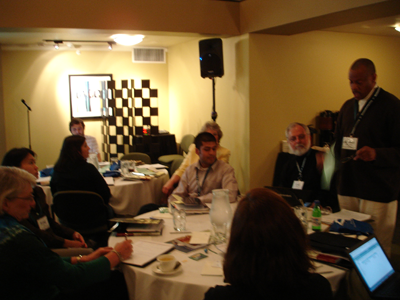Reports from Working Group Discussions (Access to Computing in Higher Education 2009)
CBI participants represented a wide range of stakeholders, including postsecondary faculty and staff, and employees of organizations serving students around the country. They brainstormed and shared ideas about how to better serve students in computing fields in postsecondary education. The following summarizes their discussions.
Question 1
What are challenges that students with disabilities face in pursuing computing undergraduate and graduate academic programs and careers?

- Some students are unprepared for the rigor of college-level studies, lacking skills such as effective note taking and study habits; others lack the prerequisite knowledge base for success.
- Some students find it difficult to complete remedial classes and progress to higher level classes.
- Some have difficulty navigating the admissions process.
- Some cannot adjust to the changing level of support received. Some physical spaces, curricula, and services are inaccessibly designed.
- Some students lack of knowledge about resources available to them, including assistive technology and how to use it.
- Faculty and teaching assistants are unsure of how to work with students with disabilities.
- Some faculty members have inaccurate perceptions regarding the abilities of people with disabilities. These low expectations can be challenging to overcome.
- Some students cannot find available and appropriate financial resources, including those to fund the purchase and upgrade of assistive technology.
- Some employment options in community businesses are inaccessible to potential workers with disabilities.
Question 2
How can disability support services, computing departments, veterans organizations, and other groups work together effectively to increase the number of people with disabilities in the computing sciences?
- Create a clearinghouse of information for students interested in pursuing computing and IT degrees.
- Ask for student input and advertise the resource to high school administrators and students.
- Clarify and improve military transfer articulations with colleges through collaborations with local VA offices.
- Teach students how to self-advocate effectively.
- Survey students with disabilities to get a better idea of their needs and barriers to participation.
- Address identified needs and work to remove barriers to increase classroom participation.
- Introduce assistive technology software and hardware solutions to students with disabilities.
- Demonstrate assistive technology at faculty and staff meetings.
- Install assistive technology applications in all computer labs.
- Provide internships early in the student academic careers.
- Conduct a needs assessment of potential employers and disseminate the information to students.
Question 3
How can disability-related topics be integrated into the computing and IT classroom curricula on your campus?
- Consider related accessibility and universal design topics for all class curricula.
- Include accessibility as a component to each assignment or subject studied.
- Ask an individual with a disability to present content about assistive technology and accessibility so that students can hear first hand about accessibility issues; consider providing a panel of individuals with a variety of disabilities and computing needs.
- Have students assess the accessibility of campus or business websites.
- Offer faculty training on assistive technology and accessibility that will provide them with knowledge to bring back to their classrooms.
- Develop an online resource about assistive technology or other disability-related topic.
- Work with book publishers to both include accessibility content in their curricula and provide books and supplemental classroom materials in an accessible electronic format.
Question 4
What specifically can your computing department, disability support services office, veterans organization, or other campus service do to improve the recruitment and support of students with disabilities in computing departments and careers?
- Through training and resources, increase awareness of accessibility issues and the need for universal design.
- Establish a presence at campus workshops by inviting panels of students with disabilities or speakers with disabilities to address campus accessibility needs.
- Develop courses and informational workshops on computing and assistive technology.
- Teach faculty about disability services, accommodation expectations, and assistive technology options.
- Collaborate with veterans-serving organizations on hosting informational sessions and workshops on course options in computing for people with disabilities.
- Email students with disabilities about upcoming informational sessions and internship opportunities.
- Ask students to think creatively about internships.
- Foster connections to the art department, filmmaking, journalism, and other fields using digital media.
- Ensure that computer science and IT classrooms are physically accessible.